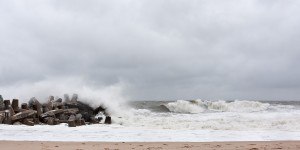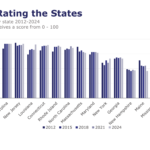Forecasters can’t completely rule out a U.S. East Coast strike by Hurricane Joaquin but are more optimistic it will miss, even as the “extremely dangerous” storm pounds the Bahamas with high winds, heavy rains and raging surf, the National Hurricane Center said.
Joaquin raked parts of the island chain on Thursday with top winds of 130 miles (210 kilometers) per hour, and that pounding will probably last into Friday, the center in Miami said in a 5 p.m. advisory. The Category 4 storm was 70 miles south of San Salvador, Bahamas, moving southwest at 6 mph.
The center has shifted its projected track for the storm, predicting it will sweep south and east of Massachusetts’ Cape Cod by Tuesday afternoon, after several more computer forecast models favored a miss by Joaquin.
“The strong majority of forecast models are now in agreement on a track farther away from the United States east coast,” Jack Beven, a senior hurricane specialist at the center, wrote in an analysis. “We are becoming optimistic that the Carolinas and mid-Atlantic states will avoid the direct effects of Joaquin.”
Beven said it wasn’t possible to completely rule out a strike by Joaquin somewhere on the coast.
Over the course of Thursday, three forecast models moved Joaquin’s projected track away from the East Coast and joined the European Centre for Medium-Range Weather Forecasts in calling for the storm to stay at sea. Three others still predict the storm will turn toward the U.S. coastline.
“This is probably going to be a non-issue,” said Gary Best, a meteorologist at Hometown Forecast Services in Nashua, New Hampshire. “It’s a little bit early, but what we are seeing now looks pretty good.”
‘Bullish’ Outlook
“I’m fairly bullish on the storm staying off shore,” said Todd Crawford, principal scientist at WSI in Andover, Massachusetts. “Probably 80 percent chance.”
Michael Schlacter, at Weather 2000 Inc., isn’t as optimistic. The storm’s continued drift to the south and west could raise the possibility the models will change or that the system would be too close to the U.S. to miss completely.
“I still contend we have to wait and see when and how this southwesterly drift stops,” Schlacter said. “You are not going to be able to tell your forward speed and what influences are going to bounce it this way and bounce it that way until it starts moving north.”
Joaquin’s slow forward speed means the misery on the Bahamas will last into Friday.
Islands across the Bahamas were under hurricane warnings and watches as Joaquin drifted across the chain. Grand Bahama Island, Eleuthera and Mayaguana were among those covered by the warning. Joaquin is an “extremely dangerous” storm, the center said.
Heavy Rain
As much as 10 to 15 inches (25 to 38 centimeters) of rain may fall across the central Bahamas, and in isolated cases up to 20 inches, which could cause life-threatening flash floods. A storm surge may raise seas as much as 8 feet above normal tide levels, with dangerous swells and rip currents being forecast across the chain, as well as in the southeastern U.S., according to the center.
Joaquin’s winds may peak at 140 mph, which would still be in the range of a Category 4 storm, the second-most powerful on the five-step Saffir-Simpson scale.
The U.S. hasn’t been hit by a major hurricane, Category 3 or stronger, for 10 years. Sandy, which struck New York and New Jersey in October 2012, was only a Category 1-strength storm.
In the meantime, preparations are under way for a possible disaster.
N.Y. Prepares
New York Governor Andrew Cuomo placed 3,000 National Guard members on standby for deployment as the Metropolitan Transportation Authority positioned pumping equipment and generators if needed by subways and mass transit. Cuomo said the state is better prepared than it was for Sandy.
“There’s no comparison to where we were before,” he said. “I just don’t want to get arrogant or cocky because I’ve been knocked to the ground a couple of times by Mother Nature.”
In addition to the hurricane threat, the eastern U.S. from New Jersey to Georgia is forecast to receive heavy rains through the next seven days, the U.S. Weather Prediction Center said. Nearly 20 inches is forecast to fall in South Carolina and western North Carolina.
Flood and flash flood watches stretch from New Jersey to Georgia and touch parts of Tennessee, Kentucky and West Virginia, the National Weather Service said.
At least one person died in South Carolina due to flooding, according to the Associated Press.
“In the Carolinas, this could be historic flooding,” said Tom Kines, a meteorologist with AccuWeather Inc. in State College, Pennsylvania. “It is a dangerous situation there for North and South Carolina, and this is without Joaquin.”
On top of all that, strong onshore winds have have prompted coastal flood advisories from Massachusetts to South Carolina, according to the weather service. The risk of shoreline flooding will only increase if Joaquin nears the East Coast, even if it fails to come ashore.
–With assistance from Stacie Sherman in Trenton and Freeman Klopott in Albany.





















 IBHS: Virginia Edges Florida Out of First Place in Building Code Adoption
IBHS: Virginia Edges Florida Out of First Place in Building Code Adoption  Executives on the Move at AIG, White Mountains, Vermont Mutual
Executives on the Move at AIG, White Mountains, Vermont Mutual  Uncertainty Keeps Prices Up; No Prior-Year Loss Development: Travelers
Uncertainty Keeps Prices Up; No Prior-Year Loss Development: Travelers  Going, Going, Gone: ‘Disruption’ to Shrink Traditional Premiums for Auto
Going, Going, Gone: ‘Disruption’ to Shrink Traditional Premiums for Auto 




